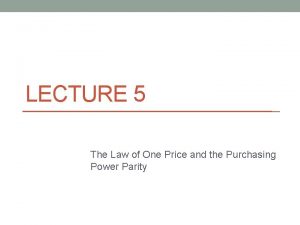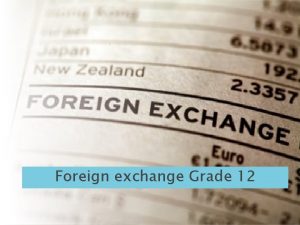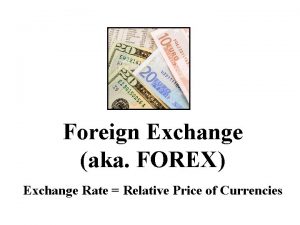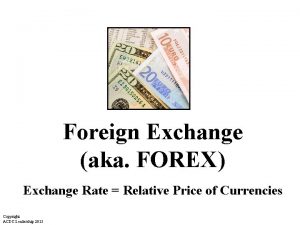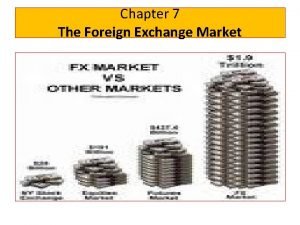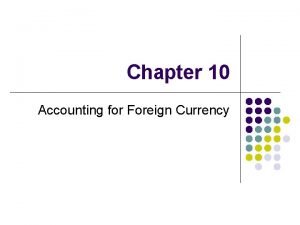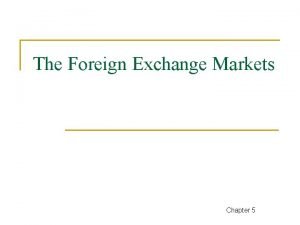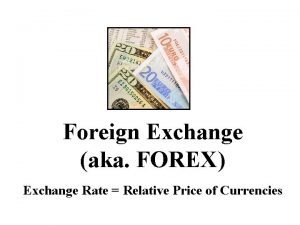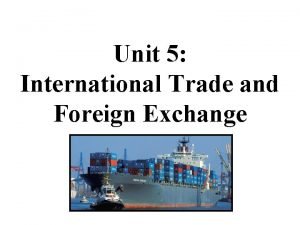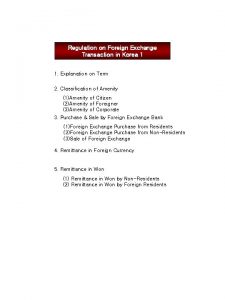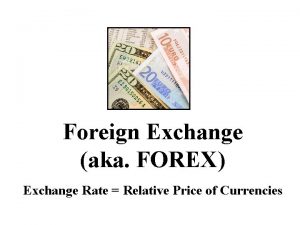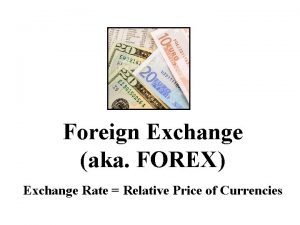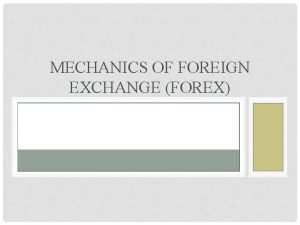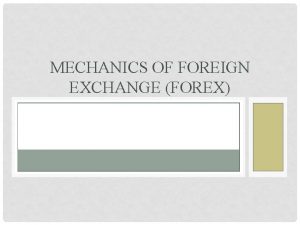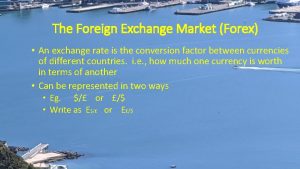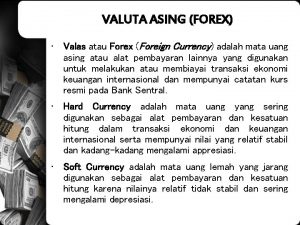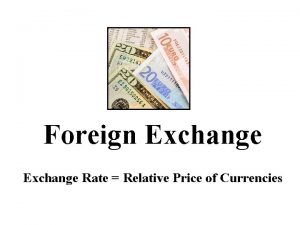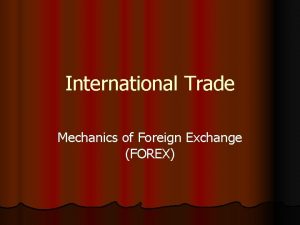Foreign Exchange aka FOREX Exchange Rate Relative Price
















- Slides: 16

Foreign Exchange (aka. FOREX) Exchange Rate = Relative Price of Currencies

Video: Down and Out Dollar

Exports and Imports 1. US sells cars to Mexico 2. Mexico buys tractors from Canada 3. Canada sells syrup to the U. S. 4. Japan buys Fireworks from Mexico For all these transactions, there are different national currencies. Each country must be paid in their own currency The buyer (importer) must exchange their currency for that of the sellers (exporter).

The turnover in FOREX markets is almost $4 trillion (USD) a day Currency Codes USD = US Dollar EUR = Euro JPY = Japanese Yen GBP = British Pound CHF = Swiss Franc CAD = Canadian Dollar AUD = Australian Dollar NZD = New Zealand Dollar

Exchange Rates In the FOREX market we only look at two countries/currencies at a time Ex: US Dollars and Euros We examine the price of one currency in terms of the other currency. Ex: $3 = € 2 The Exchange Rate depends on which currency you are converting. The price of one US Dollar in terms of Euros is 1 Dollar = € 2/$3 = €. 66 The price of one Euro in terms of Dollars is 1 Euro = $3/€ 2= $1. 5

What happens if you need more dollars to buy one euro (the price for a euro increases)? Ex: From $3=€ 2 to $6=€ 2 • The U. S. Dollar DEPRECIATES relative to the Euro. Depreciation • The loss of value of a country's currency with respect to a foreign currency • More units of dollars are needed to buy a single unit of the other currency. • The dollar is said to be “Weaker”

What happens if you need less dollars to buy one euro (the price for a euro decreases)? Ex: From $3= € 2 to $1= € 2 • The U. S. Dollar APPRECIATES relative to the euro. Appreciation • The increase of value of a country's currency with respect to a foreign currency • Less units of dollars are needed to buy a single unit of the other currency. • The dollar is said to be “Stronger”

FOREX Supply and Demand Simplified Imagine a huge table with all the different currencies from every country This is the Foreign Exchange Market! Just like at a product market, you can’t take things without paying. If you demand one currency, you must supply your currency. Ex: If Canadians want Russian Rubles. The demand for Rubles in the FOREX market will increase and the supply of Canadian Dollars will increase.

What happens if Europeans prefer vacationing in the United States? € $ Dollars $ € S er 1 Euros S ere D 1 D Quantity of Dollars S 1 ere er 1 D Quantity of Euros The Dollar APPRECIATES The Euro DEPRECIATES

FOREX Shifters Let’s use the example of the US Dollar and the British Pound

1. Changes in Tastes and Preferences. Ex: British tourists flock to the U. S… Demand for U. S. dollars increases (shifts right) Supply of British pounds increases (shifts right) Pound-depreciates Dollar-appreciates 2. Changes in Relative Incomes (Resulting in more imports)Ex: US growth increase US incomes…. U. S. buys more imports… U. S. Demand for pounds increases Supply of U. S. dollars increases Pound- appreciates Dollar- depreciates

3. Changes in Relative Price Level (Resulting in more imports)- Ex: US prices increase relative to Britain…. U. S. demand for cheaper imports increases… U. S. demand for pounds increases Supply of U. S. dollars increases Pound- appreciates Dollar- depreciates 4. Changes in relative Interest Rates- Ex: US has a higher interest rate than Britain. British people want to put money in US banks Capital/financial Flow increase towards the US British demand for U. S. dollars increases… British supply more pounds Pound-depreciates Dollar- appreciates

What will happen to the international value of the Mexican peso if there is high inflation in Mexico? Pesos The peso DEPRECIATES The demand for pesos will decrease since Mexico's trading partners will not want to purchase higher priced Mexican products. The supply will increase as Mexicans look to buy lower priced imports.

Practice For each of the following examples, identify what will happen to the value of US Dollars and Japanese Yen. 1. American tourists increase visits to Japan. 2. The US government significantly decreases personal income tax. 3. Inflation in Japan rises significantly faster than in the US. 4. Japan has a large budget deficit that increases Japanese interest rates. 5. Japan places high tariffs on all US imports. 6. The US suffers a larger recession. 7. The US Federal Reserve sells bonds at high interest rates. How do these scenarios affect exports and imports?

Practice For each of the following examples, identify what will happen to the value of US Dollars and Japanese Yen. 1. 2. 3. 4. 5. USD depreciates and Yen appreciates USD appreciates and Yen depreciates USD depreciates and Yen appreciates USD depreciates (Demand Falls) and Yen appreciates (Supply Falls) 6. USD appreciates (Supply Falls) and Yen depreciates (Demand Falls) 7. USD appreciates and Yen depreciates Scenarios 1, 2, and 4 will increase US exports because US products are now relatively “cheaper”

 Determination of exchange rate
Determination of exchange rate Ano ang kahulugan ng price ceiling at price floor
Ano ang kahulugan ng price ceiling at price floor Plant growth analysis
Plant growth analysis Law of one price exchange rate
Law of one price exchange rate Too foreign for home too foreign for here
Too foreign for home too foreign for here Fx process
Fx process Exchange rate grade 12
Exchange rate grade 12 Foreign exchange shifters
Foreign exchange shifters 4 shifters of foreign exchange
4 shifters of foreign exchange Kinds of foreign exchange market
Kinds of foreign exchange market Foreign currency accounting
Foreign currency accounting Objective of foreign exchange
Objective of foreign exchange Xlri student exchange
Xlri student exchange Forex shifters
Forex shifters International trade and foreign exchange
International trade and foreign exchange Foreign exchange transaction regulation korea
Foreign exchange transaction regulation korea Hsbc forex rates
Hsbc forex rates



